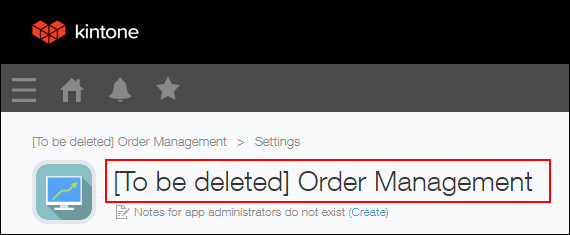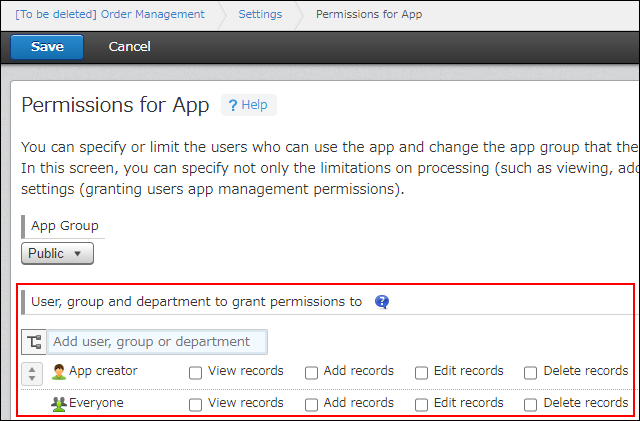Usar la columna "Última fecha de actualización del registro" para ordenar sus aplicaciones
Al utilizar la columna Última fecha de actualización del registro en la pantalla de Administración de aplicaciones, puede encontrar fácilmente aplicaciones cuyos registros no se han agregado o editado durante mucho tiempo, lo que le facilita ordenar sus aplicaciones.
Cómo utilizar la columna "Última fecha de actualización del registro"
Para obtener detalles sobre la información que se muestra en esta columna, consulte la página siguiente.
Última fecha de actualización del registro
Identificar las aplicaciones que no se están utilizando
Esta sección describe cómo utilizar la columna Última fecha de actualización del registro para encontrar las aplicaciones que probablemente no se utilicen y decidir si eliminarlas o no.
Comprobación del uso de la aplicación
-
Haga clic en el ícono Ajustes (el ícono con forma de engranaje) en la parte superior de Kintone, luego haga clic en Administración de aplicaciones.

-
En la pantalla de administración de aplicaciones, haga clic en el nombre de la columna Última fecha de actualización del registro en la sección Apps para ordenar las aplicaciones en orden ascendente (de la más antigua a la más nueva).
Apps se muestran en orden ascendente según la última fecha de registro actualizada, desde la más antigua a la más nueva, y las aplicaciones con el valor (Sin datos) se muestran primero.
Si la fecha del último registro actualizado de una aplicación es antigua o se muestra como (Sin datos), es probable que la aplicación no esté en uso.
Columnas para verificar además de "Última fecha de actualización del registro"
Por ejemplo, también puede confirmar las siguientes columnas para limitar las aplicaciones.
- Apps con Nueva aplicación mostrada en la columna Nombre
Si una aplicación tiene "Nueva aplicación" en la columna Nombre, su nombre no ha cambiado desde que se creó. - Apps con No activado que se muestran en la columna Estado
Si una aplicación tiene el valor No activado en la columna Estado, todavía se está creando y aún no se ha activado. - Apps con "0" mostrado en la columna Registros
Si una aplicación no ha tenido registros durante mucho tiempo, es posible que se haya creado como prueba y ya no esté en uso.
Apps que se deben excluir de la eliminación
Incluso si no se han agregado ni editado registros en una aplicación durante mucho tiempo, la aplicación puede usarse para el propósito principal de ver o hacer referencia a datos.
Ejemplos: Maestro de presupuesto, Maestro de tienda, Preguntas frecuentes internas
Estas aplicaciones deben conservarse y no eliminarse.
Revisar las aplicaciones existentes
A continuación se presentan algunas ideas sobre cómo puede comprobar si está bien eliminar las aplicaciones que probablemente no utilice.
- Confirme las columnas Creado por y/o Ajustes: Actualizado por en la pantalla de administración de aplicaciones y comuníquese con el usuario que aparece en ellas.

- Agregue "Para eliminar" al nombre de la aplicación y vea si hay alguna respuesta de los usuarios de la aplicación durante un tiempo.
Referencia: Cambiar Nombre de una aplicación
- Limite el acceso a la aplicación y espere un momento para ver si hay alguna respuesta de los usuarios de la aplicación.
Referencia: Configuración de permisos para aplicaciones
- Pídale al usuario "Creado por" que verifique en la pantalla de administración de aplicaciones si está bien eliminar la aplicación.
Referencia: Mostrar solo las aplicaciones creadas por usted en la sección Apps
Utilice un archivo CSV
También puedes descargar una lista de aplicaciones en un archivo CSV que contiene la información de la columna Fecha de última actualización del registro.
El archivo descargado se puede utilizar para analizar el uso de la aplicación o para crear una nueva aplicación para administrar y organizar sus aplicaciones cuando su número crezca.
